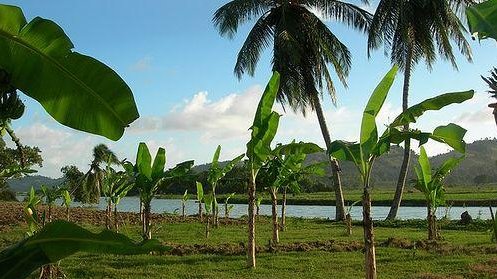JÉRÉMIE, Haiti-- Sen. Maxime Roumer, 50, of Grand’Anse department, says he’s worried about the future of the country’s national emblem: the palm tree.
“The national tree has a long-standing tradition ever since the liberations struggle from the French,” Roumer says in a phone interview. “For about 100 years, all the towns in Haiti had a central plaza, where the mayor’s office was, and right next to it always stood the tree of liberty, which symbolized revolutionary social change. On top of the palm, they placed a liberty cap, which they called the weapon of the republic.” This symbol stands on a white square in the middle of Haiti’s blue-and-red flag. Article 52.1 of the Haitian Constitution obligates citizens to respect the constitution and the national emblem, he says. But every day, more palm trees are disappearing. “We only have less than 2 percent of forest cover left, and every day we are cutting more trees,” he says, speaking loudly and quickly. “First of all, the palm is our national emblem. We should be giv[ing] it more respect. And furthermore, this is a tree that takes a while to grow. If we continue this way, the palm will completely disappear.” He cites the massive destruction of the palm tree for Holy Week, when people cut the trees down to use their leaves for worship. Though he recognizes that this annual practice is tradition, he says it’s threatening the national emblem of Haiti. “What I am saying is that what we could do 100 years ago, we can no longer do,” he says. A native of Jérémie, a town in the Grand'Anse department, the senator urges citizens to reprioritize. “It is not only in Haiti that people eat hearts of palm,” he says. “This is considered a food of high quality in a number of Caribbean countries, a refined food. But at the same time, the way things are going, we will need to make a decision.” He says the government needs to do more to conserve the palm tree. But as many people in the country lack basic needs, the tree’s future looks bleak, he adds. “The negligence of the authorities, who should be concerned about this, makes the situation worse every day,” Roumer says. “In some sense, if the lives of people do not have much importance in their eyes, then the palm has certainly even less importance.” He says this reflects the overall weakness of the state. “We have a state in this country that is practically nonexistent,” he says. “Instead of talking about it, we should be reconstructing it.” He views young people as key in this reconstruction. “The kind of state we need is for the young people to reconstruct,” he says. “Young people need to think differently and begin to put a different structure into place.” The palm tree has various uses in Haiti, from religious to cultural to economic. But rapid deforestation to fuel these uses threatens the future of the palm tree, the national emblem of Haiti. Beyond promoting natural pride, palm trees also aid in soil conservation, which serves as a defense against the country’s frequent natural disasters. Haiti is off track to meet targets to ensure environmental sustainability – goal seven of the Millennium Development Goals, a U.N. anti-poverty initiative that countries worldwide have agreed to complete by 2015. One target is to significantly reduce the rate of loss of the proportion of land area covered by forest.















